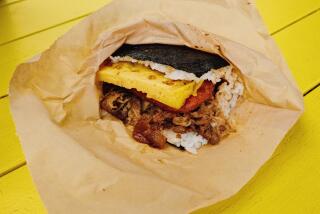It’s not just dessert: On eve of Korea summit, a mango mousse’s map throws Japan out of joint
- Share via
Reporting from Tokyo — Velvety and decadent, mango mousse may have seemed like a properly regal dish to serve at a historic summit that will bring the leaders of the two Koreas together to discuss weighty issues such as nuclear weapons and a formal end to the Korean War.
If only it were that simple.
Japan, which is watching the Korean summit from afar, expressed alarm this week when publicity photos of the planned dessert showed the mousse would be topped with a map of the Korean peninsula and a pair of disputed islands.
“It is extremely regrettable,” a Japanese Foreign Ministry spokeswoman said Wednesday, adding that Japan had lodged a protest. “We have asked that the dessert not be served.”
From shrimp to mango mousse, food has long been a diplomatic weapon in the arena of the complex, fraught and sometimes petty geopolitics of East Asia.
When President Trump sat down for a state dinner with South Korean counterpart Moon Jae-in in November, on the menu was shrimp caught in the waters off an island at the center of a long-running territorial dispute between Seoul and Tokyo.
The South Korean government made sure the world got to hear that the seafood originated from the island, known locally as Dokdo, but referred to in Japan as Takeshima.
Whether the not-so-subtle barb was merely an appeal to nationalist sentiment at home, or was driven by resentment at Trump having stopped off in Japan before arriving South Korea on his five-nation Asia tour, only President Moon knows for sure. But Japan’s government duly took the bait and formally protested the menu in an almost inevitable act of political theater.
“We have to lodge our protests; it’s part of the ritual,” said Jun Okumura, a political analyst at the Meiji Institute for Global Affairs in Tokyo.
Fast-forward to this week, and all eyes in the region are on the summit Friday between North and South Korea, a gathering that will mark the first time a leader from the North has stepped foot in the South since the Korean War.
But, once again, some of those eyes are focused on what the leaders will be feasting on.
Seoul’s presidential Blue House presented a menu for the summit, to be attended by Moon, North Korea’s supreme leader, Kim Jong Un, and other senior figures from both sides, that leaned heavily on geography. There is a Korean “reinterpretation” of Swiss rosti, a bit of nostalgia perhaps for Kim, who went to school in Switzerland. There is John Dory fish from the south to be served along with croaker from the north. And, at Moon’s request, cold buckwheat noodles prepared by a chef from one of North Korea’s best known restaurants were added to the menu.
And then there was the mango mousse.
A photograph of the dessert released by Seoul shows a breathtaking confection, topped with a blue outline of the Korean peninsula clearly featuring the disputed island as part of a united Korea. The island is administered by South Korea, but Japan has long claimed it is part of its Shimane prefecture.
Japan’s Foreign Ministry followed the playbook and made a complaint through diplomatic channels, as it had done when a flag decorated with a similar map was waved by supporters of the joint North and South Korean ice hockey team at the recent Winter Olympics in Pyeongchang, South Korea.
“There is always a status quo, whether it is the Northern Territories [disputed islands controlled by Russia], the Senkakus [islands controlled by Japan and claimed by China] or Takeshima,” said Okumura. “When one side expresses an opinion, be it through an official document, a school textbook or a mousse, the other side has to respond.”
“It’s not only the mousse, the united Korea map with Dokdo on it is also on the chairs. It would be better if we did not just protest, but said ‘goodbye’ to South Korea. There is no need to make efforts to improve bilateral relations, which are getting worse, with South Korea,” wrote a Twitter user named @shinjukuacc. “Of course the entire blame for things getting worse lies with South Korea.”
Moon, who has promised Japanese Prime Minister Shinzo Abe that he will raise with Kim the issue of Japanese citizens abducted by North Korea in the 1970s and 1980s, is almost certainly playing to the gallery with the culinary shenanigans.
“This is a good way for President Moon to grab some nationalist credentials at home, as he did by serving the Dokdo shrimp to Mr. Trump,” said Stephen Nagy, senior associate professor at Tokyo’s International Christian University and distinguished fellow for the Asia Pacific Foundation of Canada. “And Japan is such a convenient target; it’s an easy political win for Moon.” Japan, Nagy said, has a knack for misplaying its hand.
“Then Japan does the stupid thing and reacts, which makes the Koreans happy,” Nagy said. “It was really poor taste the way the Japanese government reacted to this. They could have expressed some kind of camaraderie and support for the summit.”
Revenge may be a dish best served cold, and the Tokyo 2020 Olympics may provide the perfect opening for Japan to turn the tables and serve a dish loaded with political significance.
Blair is a special correspondent
More to Read
Sign up for Essential California
The most important California stories and recommendations in your inbox every morning.
You may occasionally receive promotional content from the Los Angeles Times.













